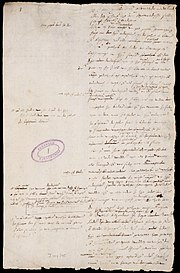Poster from Verlatinghe
The Plakkaat van Verlatinghe , also known as the Van Afzwering Act , was the official declaration of the Republic of the Seven United Provinces signed on July 26, 1581 in The Hague , with which Philip II , ruler of the Spanish Netherlands , was formally deposed as ruler of these provinces. It is considered the Republic's declaration of independence .
background
The document marks a political climax in the Eighty Years' War , at the end of which the Republic of the Seven United Provinces achieved recognition of its independence from Spain in the Peace of Munster .
As a reaction to the Catholic southern provinces, which in the Union of Arras (Dutch: Unie van Atrecht ) had expressly declared themselves to be Catholic Spain in 1579 , the seven northern provinces of Holland , Zeeland , Utrecht , Gelderland , Overijssel , Groningen and Friesland founded on 23 January 1579 the Union of Utrecht , a forerunner of the Republic of the Seven United Provinces. Attempts by William of Orange to mediate between the two parties failed. He himself joined the Union of Utrecht, with which the history of an independent Dutch state began.
In 1581 the provinces connected to the Union of Utrecht declared their formal independence from Philip II of Spain , whom they formally deposed, and became a republic under the leadership of the States General . The post of governor was given to William of Orange, who had led the resistance struggle.
The Assembly of the States General then elected Franz von Anjou as sovereign. After his death in 1584 and the murder of William of Orange in the same year, however, no successor could be found, as both the English queen and the French king refused the offer in order not to provoke Philip. The result was the emergence of a republic from the united provinces of the Union of Utrecht.
Poster from Verlatinghe
The Plakkaat van Verlatinghe stated that all residents of the above-mentioned countries “are from now on released from the oath that they have taken or are obliged to take to the King of Spain, since he was the ruler of these countries ” ( voortane ontslagen van den eede die zy den Coninck van Spaegnien, as heere van dese voorsz. land gheweest lifting, moghen eenichsins ghedaen lifting often in hem ghehouden being ). The authors of the declaration justified their secession from the Spanish crown by stating that the Spanish king had failed as sovereign because he did not protect his subjects from injustice, harm and violence and because he had violated the rights of his subjects, in particular by disregarding the great privilege .
Provinces
The provinces named in the declaration are (in the order in which they are named):
The provinces of Groningen and Overijssel (including Drenthe ) also renounced themselves, but were not mentioned separately because they were viewed as parts of Geldern and Utrecht, respectively.
aftermath
There is some evidence that the Plakkaat van Verlatinghe served as the model for the US Declaration of Independence , which was written by Jefferson in 1776 (Lucas, 1994).
literature
- SJ Lucas: The Plakkaat van Verlatinge: A neglected model for the American Declaration of Independence. In: Rosemarijn Hoefte, H. Kardux (Ed.): Connecting Cultures. The Netherlands in five centuries of transatlantic exchange. VU Univ. Press, Amsterdam 1994, ISBN 90-5383-344-7 , pp. 187-207.
- Stephan Laux: The "Plakkaat van Verlatinge" (1581). The Dutch States General, the question of sovereignty and the problem of the “quasi-secular” right of resistance. In: Gerhard Rehm (Ed.): Nobility, Reformation and City on the Lower Rhine. Festschrift for Leo Peters . Publishing house for regional history, Bielefeld 2009, ISBN 978-3-89534-853-2 , pp. 169–187.
